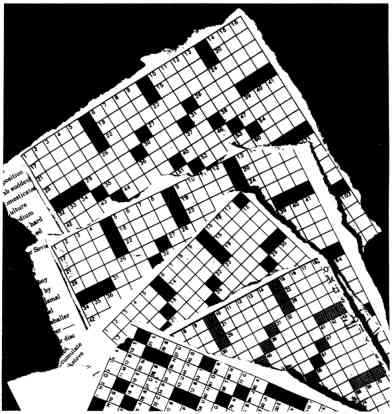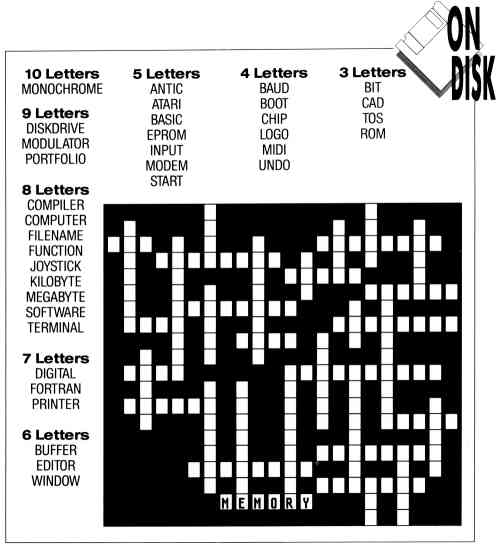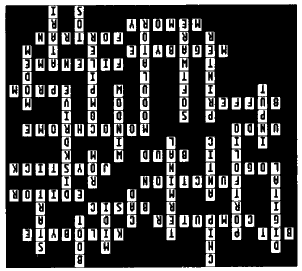A Reverse Crossword-Puzzle Generator
Remember the popular Crossword Creator published in the June 1990 issue? At the risk of starting a trend, we present another puzzle creator - with a twist.
BY CAROLYN ROGERS

Imagine a crossword puzzle without clues. Sounds impossible to solve, doesn't it? Okay, we'll fill in one of the words and leave you the rest. What? Still can't solve it? Fine, we'll give you a list of all the words that go into the puzzle. Now, maybe, just maybe, you can fill it in!
The Fill-It-In Concept
This program generates and prints Fill-It-In word puzzles, which are
similar to crossword puzzles except you get a list of words instead of
clues. Working from the key word, you fit the remaining words into the
puzzle. To help you, the words are grouped according to the number of characters
they contain, so if you need a three-letter word that ends with 'T,' you
only have to look in the three-letter section to find one.
Creating A Puzzle
From your backup START disk, double-click on FILL_ARC.PRG and choose
Extract when the dialog box appears. Use the file-selector to choose your
destination disk and four files will un-ARC to that disk.
To play Fill-It-In, make sure PUZZLE.PRG and PUZZLE.RSC are in the same folder, then double-click on PUZZLE.PRG. Now we're ready to make puzzles.
How It Works
The main screen presents nine option buttons:
Load Old List: Loads a saved puzzle list into memory. A list has the extension .LIS.
Create New List: Select this to enter a new list of between four and 80 puzzle words. Be sure to hit the [Caps Lock] key, as the form requires uppercase words. The following keys are used for editing the form:
[Up arrow] - moves up one field
[Down arrow] - moves down one field
[Right arrow] - moves right one character
[Left arrow] - moves left one character
[Backspace] - removes character to left of cursor
[Delete] - deletes character to right of cursor
[Escape] - clears field
After finishing, choose FINISHED to save the list, or ABANDON to abort. If you save the list to disk, you must give the file the extension .LIS.
Load Old Puzzle: Load a saved puzzle into memory. Puzzle files have the extension .PUZ.
Generate Puzzle: Generates a puzzle using the word list currently in memory. After showing you the completed puzzle, you are given the option of printing it.
This function uses the standard GEM screen dump (the same routine that is called when you choose Prim Screen from the Desktop) SO if the puzzle doesn't print properly, you may need to adjust your printer settings by exiting the program, then selecting Install Printer from your Control Panel accessory. Choose the Pixels/Line setting that isn't currently highlighted.
Next, you are asked if you want to save the puzzle to disk. Be sure to give the filename a .PUZ extension. If you don't like the word distribution of the puzzle, simply run the Generate Puzzle option again. Generally, about one-half of an 80 word list is used in the puzzle.
Print Puzzle Key: Displays on the screen the master key to a generated puzzle. You have the option of printing the key.
|
|
|
| Program:
Type: Requirements: Arcfile: Files:
Language: |
Fill-It-In
Puzzle generator 512K, medium or high rez FILL_ARC. PRG PUZZLE.PRG STARTREK.LIS
Modula-2 |

Print Puzzle: Displays the current puzzle in memory on the screen and asks if you want a screen dump. Following the screen dump, a list of the selected words is printed. Be sure to generate or load a puzzle first or strange things may happen.
Save Current Puzzle: Choose this to save your completed puzzle to disk. Be sure to give the filename a .PUZ extension.
Edit Current List: After loading a saved list or creating a new one, you may edit the list using this option. See the CREATE NEW LIST item above for a description of the editing keys.
Exit Program: Returns to the Desktop.
Beam Me Up
Before you create your own Fill-It-In puzzle, try solving one first.
Load STARTREK.PUZ, then print it out. One nice thing about Fill-It-In is
that you don't have to be familiar with the words in the list to solve
the puzzle. You just need the skill to recognize where they go.
Carolyn Rogers was, until recently. a programmer for Uncle Sam. She wrote "An Introduction to Modula-2 " in the September 1989 issue.
